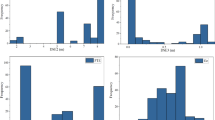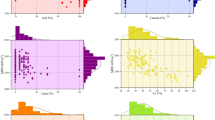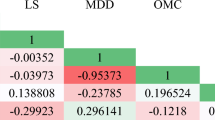Abstract
The density of embankment fill soil material is a crucial factor determined by the maximum dry density (MDD) in transport construction projects. Traditionally, the modified proctor test is conducted in laboratories to determine this parameter. However, this paper presents a novel method that utilizes decision tree (DT) analysis to forecast the MDD of soil stabilizing mixtures. The DT method is employed to create accurate and comprehensive models that establish relationships between the MDD of stabilized soil and various natural soil properties, including particle size distribution, plasticity, linear shrinkage, and the type and quantity of stabilizing additives. These models are trained, validated, and tested with an experimental dataset of soil types obtained from previously published stabilization test results. The study concludes that DT is a viable alternative approach for predicting MDD based on input parameters. To enhance the accuracy of the DT model in predicting MDD, two meta-heuristic algorithms, namely Escaping Bird Search optimization and Runge–Kutta optimization, are integrated. This integration led to the development of two hybrid models, DTEB and DTRU. The DTEB model achieves impressive coefficient correlation (R2) values of 0.9950, 0.9863, and 0.9908 for the training, validation, and testing data, respectively. Additionally, DTEB demonstrates the most favourable root-mean-square error of 16.60. Overall, the DTEB model demonstrates acceptable predictive ability and superior generalization ability compared to the DT and DTRU models developed in this study.






Similar content being viewed by others
References
Janjua ZS, Chand J (2016) Correlation of CBR with index properties of soil. Int J Civ Eng Technol 7(5):57–62
Duque J, Fuentes W, Rey S, Molina E (2020) Effect of grain size distribution on california bearing ratio (CBR) and modified proctor parameters for granular materials. Arab J Sci Eng 45:8231–8239
Preethi S, Tangadagi RB, Manjunatha M, Bharath A (2020) Sustainable effect of chemically treated aggregates on bond strength of bitumen. J Green Eng 10(9):5076–5089
Akpokodje EG (1985) The stabilization of some arid zone soils with cement and lime. Q J Eng Geol 18(2):173–180
Bell FG (1996) Lime stabilization of clay minerals and soils. Eng Geol 42(4):223–237
Alavi AH, Gandomi AH, Gandomi M, Sadat Hosseini SS (2009) Prediction of maximum dry density and optimum moisture content of stabilised soil using RBF neural networks. IES J Part A Civ Struct Eng 2(2):98–106
Ngowi AB (1997) Improving the traditional earth construction: a case study of Botswana. Constr Build Mater 11(1):1–7
KS C, YM OM, Mohamad Ghazali SK, (2015) Estimating maximum dry density and optimum moisture content of compacted soils. In: international conference on advances in civil and environmental engineering, pp 1–8
Bharath A, Manjunatha M, Reshma TV, Preethi S (2021) Influence and correlation of maximum dry density on soaked & unsoaked CBR of soil. Mater Today Proc 47:3998–4002
Suman S, Mahamaya M, Das SK (2016) Prediction of maximum dry density and unconfined compressive strength of cement stabilised soil using artificial intelligence techniques. Int J Geosynth Gr Eng 2:1–11
Hossein Alavi A, Hossein Gandomi A, Mollahassani A, Akbar Heshmati A, Rashed A (2010) Modeling of maximum dry density and optimum moisture content of stabilized soil using artificial neural networks. J Plant Nutr Soil Sci 173(3):368–379
Metropolis N, Rosenbluth AW, Rosenbluth MN, Teller AH, Teller E (1953) Equation of state calculations by fast computing machines. J Chem Phys 21(6):1087–1092
Alavi AH, Heshmati AA, Gandomi AH, Askarinejad A, Mirjalili M (2008) Utilisation of computational intelligence techniques for stabilised soil. In: 6th international conference on engineering computational technology, ECT 2008
Narendra BS, Sivapullaiah PV, Suresh S, Omkar SN (2006) Prediction of unconfined compressive strength of soft grounds using computational intelligence techniques: a comparative study. Comput Geotech 33(3):196–208
Banzhaf W, Nordin P, Keller RE, Francone FD (1998) Genetic programming: an introduction: on the automatic evolution of computer programs and its applications. Morgan Kaufmann Publishers Inc, Cambridge
Koza J (1992) Genetic programming, on programming of computer by natural selection. MIT Press Cambridge, MA
Masoumi F, Najjar-Ghabel S, Safarzadeh A, Sadaghat B (2020) Automatic calibration of the groundwater simulation model with high parameter dimensionality using sequential uncertainty fitting approach. Water Supply 20(8):3487–3501. https://doi.org/10.2166/ws.2020.241
Mahesh B (2020) Machine learning algorithms-a review. Int J Sci Res (IJSR) 9:381–386
Zhou Z-H (2021) Machine learning. Springer Nature, Cham
Wang H, Lei Z, Zhang X, Zhou B, Peng J (2016) Machine learning basics, Deep Learn, pp 98–164
Biau G (2012) Analysis of a random forests model. J Mach Learn Res 13(1):1063–1095
Kim K (2003) Financial time series forecasting using support vector machines. Neurocomputing 55(1–2):307–319
Jordan MI, Mitchell TM (2015) Machine learning: trends, perspectives, and prospects. Science 349(6245):255–260
Myles AJ, Feudale RN, Liu Y, Woody NA, Brown SD (2004) An introduction to decision tree modeling. J Chemom A J Chemom Soc 18(6):275–285
Song Y-Y, Ying LU (2015) Decision tree methods: applications for classification and prediction. Shanghai Arch psychiatry 27(2):130
Magerman DM (1995) Statistical decision-tree models for parsing, arXiv Prepr. C
Kotsiantis SB (2013) Decision trees: a recent overview. Artif Intell Rev 39:261–283
Taffese WZ, Abegaz KA (2022) Prediction of compaction and strength properties of amended soil using machine learning. Buildings 12(5):613
Karbassi A, Mohebi B, Rezaee S, Lestuzzi P (2014) Damage prediction for regular reinforced concrete buildings using the decision tree algorithm. Comput Struct 130:46–56
Erdal HI (2013) Two-level and hybrid ensembles of decision trees for high performance concrete compressive strength prediction. Eng Appl Artif Intell 26(7):1689–1697
Ahmad A et al (2021) Prediction of compressive strength of fly ash based concrete using individual and ensemble algorithm. Materials (Basel) 14(4):794
Hedenström A, Rosén M (2001) Predator versus prey: on aerial hunting and escape strategies in birds. Behav Ecol 12(2):150–156
Lentink D et al (2007) How swifts control their glide performance with morphing wings. Nature 446(7139):1082–1085
Howland HC (1974) Optimal strategies for predator avoidance: the relative importance of speed and manoeuvrability. J Theor Biol 47(2):333–350
Shahrouzi M, Salehi A (2020) Design of large-scale structures by an enhanced metaheuristic utilizing opposition-based learning. In: 2020 4th conference on swarm intelligence and evolutionary computation (CSIEC), IEEE, pp 27–31
Ahmadianfar I, Heidari AA, Gandomi AH, Chu X, Chen H (2021) RUN beyond the metaphor: An efficient optimization algorithm based on Runge Kutta method. Expert Syst Appl 181:115079
Yousri D et al (2022) Modified interactive algorithm based on Runge Kutta optimizer for photovoltaic modeling: justification under partial shading and varied temperature conditions. IEEE Access 10:20793–20815
Funding
No Funding.
Author information
Authors and Affiliations
Corresponding author
Ethics declarations
Conflict of interest
The authors declare no competing of interests.
Additional information
Publisher's Note
Springer Nature remains neutral with regard to jurisdictional claims in published maps and institutional affiliations.
Rights and permissions
Springer Nature or its licensor (e.g. a society or other partner) holds exclusive rights to this article under a publishing agreement with the author(s) or other rightsholder(s); author self-archiving of the accepted manuscript version of this article is solely governed by the terms of such publishing agreement and applicable law.
About this article
Cite this article
Weifang, Z. Predicting the Maximum Dry Density of Soil by Using the Individual and Hybrid Framework of the Decision Tree. Indian Geotech J (2023). https://doi.org/10.1007/s40098-023-00827-z
Received:
Accepted:
Published:
DOI: https://doi.org/10.1007/s40098-023-00827-z




